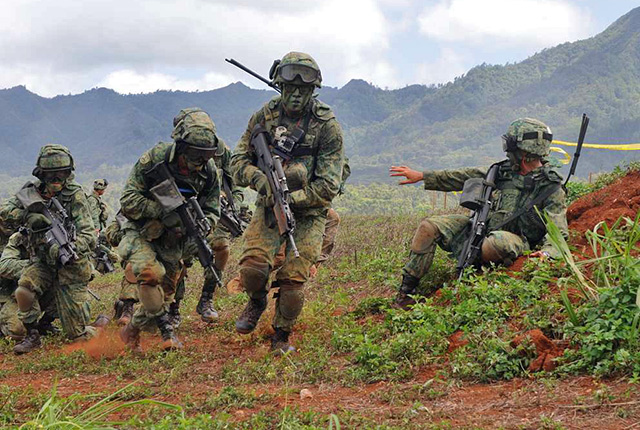The Singapore Army requires new recruits and serving soldiers to undergo regular fitness assessments. Below is some information about the fitness requirements and standards. This information is presented for discussion and may be out of date - for up to date information see official sources.
Singapore Individual Physical Proficiency Test
New Protocol: The testing protocol changed, with every soldier in Singapore undergoing a new physical fitness test from about April 2015. The new protocol scrapped the chin-up, standing broad jump, 4x10m shuttle, and added push-ups. So the IPPT now composes the sit-up test, push-up test and 2.4km run. Servicemen and women must achieve the IPPT standards set according to their gender and age.
 Singaporean soldiers of the 23rd Singapore Infantry Brigade during an exercise in 2014
Singaporean soldiers of the 23rd Singapore Infantry Brigade during an exercise in 2014Old Protocol: The test was introduced in 1979. After initial changes, the protocols 1982 until 2015 remained unchanged. Until recently, the Individual Physical Proficiency Test (IPPT) had five stations: the chin-up, standing broad jump, 4x10m shuttle, sit-up and the 2.4km run. Participants undertook the test in army T-shirts, slacks and boots.
Disclaimer
The workplace assessment tests listed here are believed to be accurate at the time it was accessed. Testing protocols and standards are often changed. Please see official sources for accurate up to date information. If you have corrections please contact me or use the comments form below.
Related Pages
- Army Fitness Testing around the world.
- Testing in other armed forces and similar services
- Poll: Should women have the same fitness testing standards as men?
- Descriptions of the three APFT test procedures: sit up, push-up and 2-mile run.
- Videos of forces fitness testing
Comments
Selected comments may be posted here.
- I went through the Singapore National Service from 1975 to 1977. 2.5 years for NCOs and Officer ranks. Reserves from 1977 to 1980. I am now a US citizen US Army veteran.
The qualifying run to pass advanced Infantry training was 6 miles with uniform, boots, metal helmet, m16 rifle, belt, bayonet, 1 canteen of water, and toggle rope. 3 miles up and 3 miles down. This was in 1975. Then I attended SSL - School of Section (squad) Leaders! More physical requirements that made the US Ranger school look like a cake walk! That was for 5 months. Then Sniper School where one of the qualifying missions was an 80 km movement to take out a target. The sniper course was 10 weeks of unmitigated hell. The physical requirements today are a joke! (from Richard Chelvan, Dec 2021)


 Current Events
Current Events